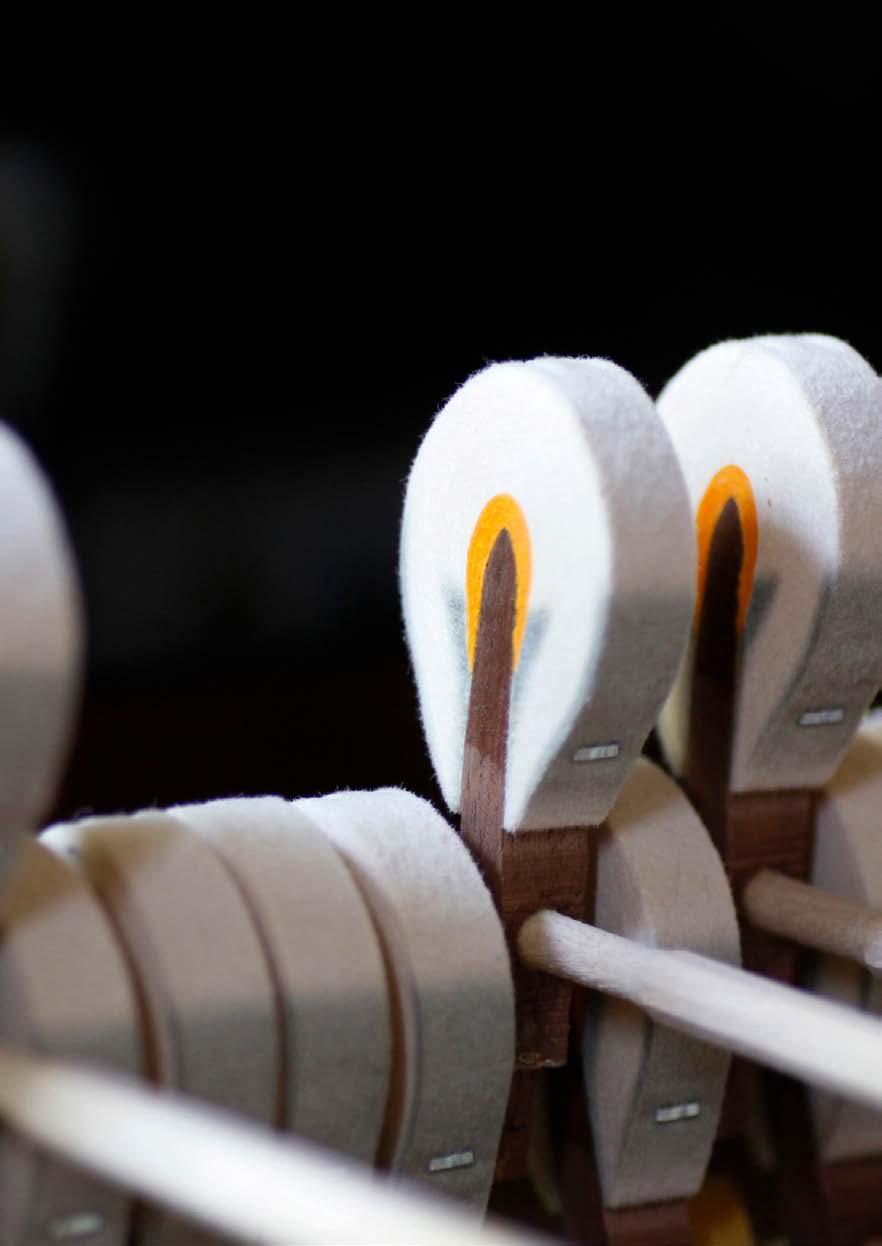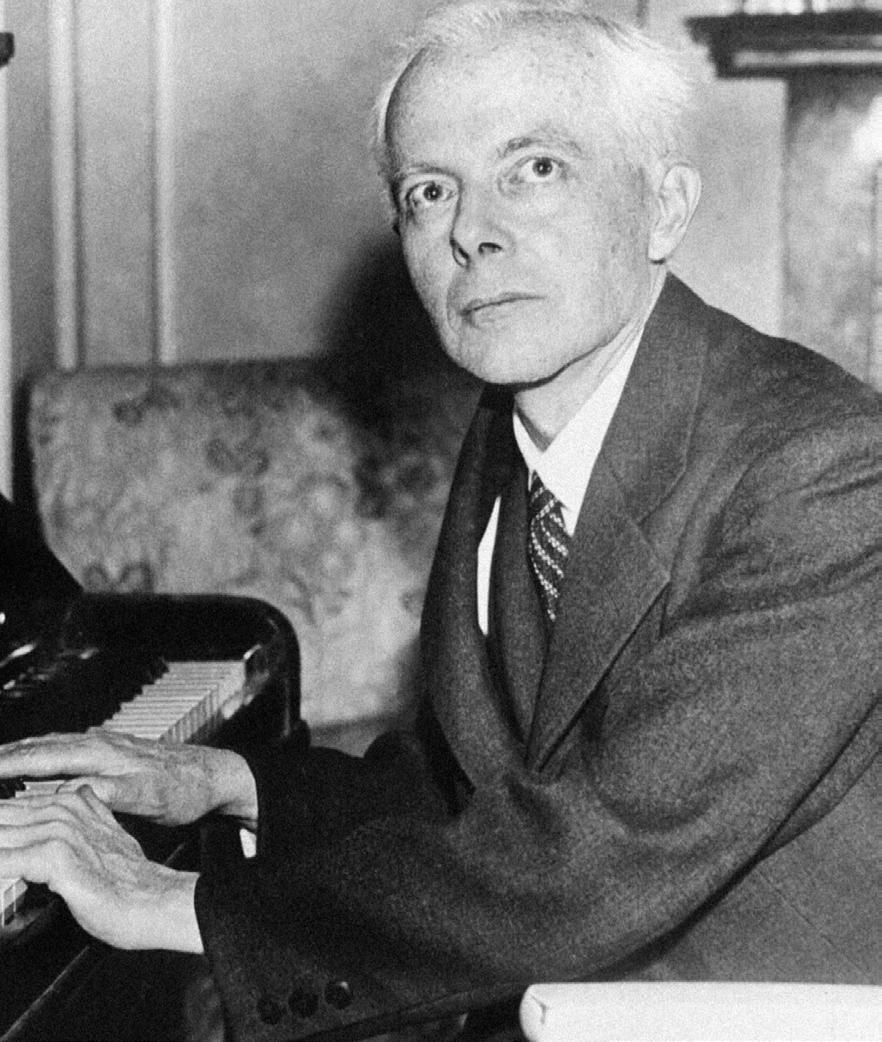

Rush Hour: Martha & Lahav Fri 27 September 2024 · 17.30
Béla Bartók, London 1936: Photo Wide World
Photos, collection National Portrait Gallery.




Rush Hour: Martha & Lahav Fri 27 September 2024 · 17.30
Béla Bartók, London 1936: Photo Wide World
Photos, collection National Portrait Gallery.

piano Martha Argerich and Lahav Shani
percussion Danny van de Wal and Martijn
Boom
Sergei Rachmaninoff (1873-1943 )
Suite No. 2 for two pianos, Op. 17 (1901)
• Introduction
• Waltz
• Romance
• Tarantella
Béla Bartók (1881-1945)
Sonata for two pianos and percussion (1937)
• Assai lento - Allegro molto
• Lento, ma non troppo
• Allegro non troppo
Concert ends at around 18.30
Cover: Photo Anton Havelaar
Blaník. Omslagillustratie door Antonín König voor de eerste uitgave van Smetana’s partituur (1894) Richard-Strauss-Institut
In the autumn years of his life, Sergei Rachmaninoff was forced to recognise that the world saw him increasingly as an outmoded composer. It was only just before his death that Béla Bartók started to receive the recognition that he had for so long deserved. In our time, they are counted amongst the greatest. Justice can take its time.
In the world of classical music no one is ever too old, and this year’s great anniversary is dedicated to Sergei Rachmaninoff: one hundred and fifty years young, and only in recent times taken really seriously. For a long time he had been dismissed by critics and even musicologists as a composer of kitsch, a romantic fossil in a new age. Caught up in the October Revolution of 1917, Rachmaninoff had been catapulted from old Russia to modern New York with an abruptness that his composing style was unable to keep pace with. Naturally, there was nothing he could do about it. In the United States he enjoyed technological innovations and pioneered recordings of his piano playing, but at the same time he sighed: ‘I can’t let go of the old way of composing and learn the new. I have done my level best to empathise with contemporary composition, but it is not my style’. He remained appreciated as a pianist, however; so much so that due to his hectic concert schedule there was hardly any time for composing, and therefore no time for rejuvenating his compositional style.
Piano orgy
Perhaps it is because the period of post-war reconstruction is drifting further into the past –
a time when the sledgehammer was bringing so much down – or because the concert audiences of today have largely grown up with pop music where stylistic rules are much less prevalent; at any rate, Rachmaninoff’s ‘old-fashionedness’ is no longer an issue these days. What does count is that he was entirely original and had his own, very recognisable style. Although often characterised as ‘typically Russian’, his Suite No. 2 for two pianos from 1901 contains influences from Liszt, Chopin, and Schumann, together with a primal Italian tarantella in the last movement. But above all one can hear how closely the young Rachmaninoff clung to his idol Tchaikovsky – another Russian who drew his inspiration in part from various other European countries.
Around the turn of the century Rachmaninoff had recovered from a depression that had prevented him from composing. This suite represents the first fruits of his recovery, composed at the same time as the Piano Concerto No. 2, that would bring him worldwide fame. ‘I am again so full of new ideas; more than I can squeeze into a concerto’, he declared. The enthusiasm underlying these words also radiates from the suite: there can be no greater proof that Rachmaninoff’s palette encompassed more than the proverbial Slav melancholy. The work is indeed an orgy of piano sound, in which the intimate relationship between composer and instrument is audible in every note.
The composer is immediately identifiable in the first few seconds of his Sonata for two pianos and percussion: Béla Bartók. The alarming sounds would fit well in a horror film, as would many other passages from his work. Director Stanley Kubrick eagerly used Bartók’s most
Blaník: omslagillustratie: door Antonín König voor de eerste uitgave van Smetana’s partituur (1894).
tense music in the cult classic The Shining. But Bartók was also composer of the amiable Romanian Dances and his neo-Classical Piano Concerto No. 3, which portray the composer in an entirely different light. His work is diverse and richly contrasting – which should come as no surprise given that he was the product of one of the most turbulent periods of European history. Bartók witnessed the end of one world war and the looming of another. Meanwhile, he experienced the rapid developments in music across Europe, although there was some delay in them reaching his home base of Hungary. Bartók takes a somewhat separate place alongside the other great music innovators. He didn’t form any school, like Arnold Schönberg, he did not have the caressing sounds of Debussy, nor the chameleon-like versatility of Stravinsky. His originality had been underappreciated for a long time; wider recognition of his music did not emerge till after his death.
As varied as they were, Bartók’s compositions at least shared one thing in common: their relationship with folk music. That was nothing new; in the nineteenth century taking inspiration from folklore was the rule rather than the exception, and when Bartók appeared on the scene the fashion was already on its way out. Bartók, however, was the first to research folk music on a scientific basis, together with his colleague Zoltán Kodály. The ancient peasant dances that he discovered in the remote parts of Hungary, Bulgaria and Romania proved to be as rich and varied as western art music. In his compositions, Bartók combined these traditional folkmusic elements with modern compositional techniques. This produced original but also ‘transverse’ music, full of scraping sounds and pounding rhythms. Bartók was searching for no polished soundscape, but the purity of that authentic folklore.
Strikingly, music was more of a means to him than an end. He was motivated to demonstrate the cultural connections between the people of the Balkans who had been endlessly beating each other’s brains out. Such a mission was not appreciated in nationalistic Hungary, where the authorities openly opposed the composer.
Bartók was searching for no polished soundscape, but the purity of authentic folklore
During the 1930s Bartók followed the rise of Nazi Germany from home in Hungary with great anxiety. Even more repellent to him was his own country’s open support for Hitler. The atmosphere of fear and threat, already features of his compositional style, was prominent in the compositions from that period and also characterises sections of the sonata being performed in this concert.
The unusual scoring fitted Bartók like a glove, being more a man of rhythm than melody, as evidenced by the usually percussive sound of his works for solo piano. The combination of piano and percussion was one he had already experimented with in his first two piano concertos. This work combines two pianos with tympani, drums, xylophone, cymbals and gong.
The first two movements clearly reflect the enormous tension Bartók was experiencing in 1937. The Finale, however – with the xylophone part cheerfully alluding to Beethoven’s Contredanses - is exuberant and is testimony to Bartók’s fundamental sense of optimism. Sadly, he never saw it rewarded. In 1940, feeling depressed, Bartók emigrated to the United States where, five years later, he died in poverty.
Michiel Cleij